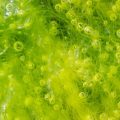The disease affects mainly older leaves of mature plants. Reddish lesions will appear on these leaves during the early stages of the infection. As the disease progresses, the lesions enlarge and tum white to light brown or grey in the centre with a purple, dark brown or blackish margin. The lesions are circular or irregular in shape and vary in size depending on the time of infection. A concentric zonation of the spots occurs alternating dark and light brown or red margins. Affected leaves eventually become pale in colour and finally, fall off.
The symptoms are caused by a fungus of the Cercospora family that attacks cotton plants, Mycosphaerella gossypina. It is different from those that affect other crops such as soybean or pepper. In the field, it is often difficult to differentiate Cercospora leaf spot from other foliar diseases, such as target spot. However, the specificity of this disease lies in the fact that it is often found in cotton plants undergoing episodes of stress such as drought or nutrient deficiency (mainly potassium). Maintaining plant vigour by having a proper fertilization scheme and preventing drought stress through proper irrigation helps to delay primary infections significantly. It will also reduce the severity of the outbreaks. The disease is favoured by temperatures between 20-30 °C and high relative humidity. Spores are dispersed onto healthy leaves by wind and water splashing.
Chemical Control:
Always consider an integrated approach with preventive measures and biological treatments if available. Spray formulations containing Tilt / Zerox (Propiconazole 25% EC) @ 200ml/Acre show also produce good results.
ShareFor such important information related to the agriculture sector and farmers, do read Gramophone articles daily. If you liked today’s information then don’t forget to share.




